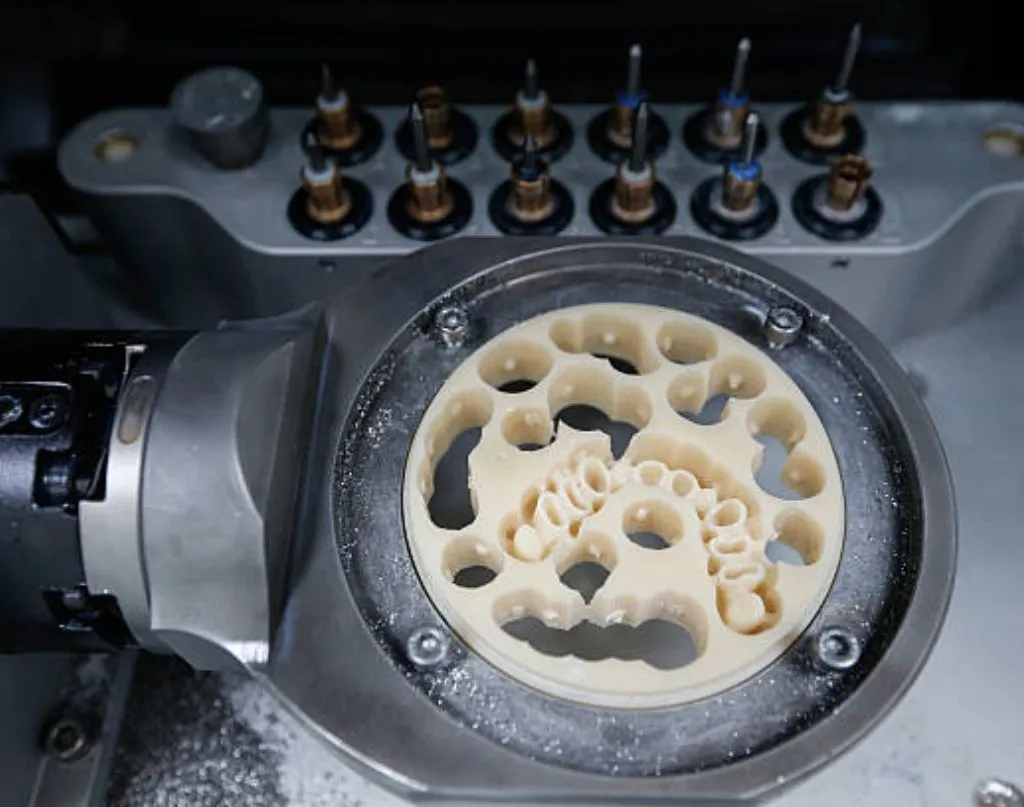Cad / Cam Milled Dental Crowns
- Home
- Cad / Cam Milled Dental Crowns
About Cad/Cam Milled Dental Crowns
Dental crowns are prosthetic devices used to replace damaged, decayed, or missing teeth. They cover the entire tooth, restoring its shape, size, strength, and function. Crowns can be made from various materials, such as metal, porcelain, ceramic, resin, or a combination of these. Traditionally, crowns were made by hand, using plaster models and dental impression trays. However, with the advent of computer-aided design and computer-aided manufacturing (CAD/CAM) technology, a new method of crown fabrication has emerged – Cad/Cam milled dental crowns.
In this page, we will explore the world of Cad/Cam milled dental crowns, including what they are, how they are made, and what benefits they offer. We will also look at the different types of Cad/Cam milled dental crowns and the processes that dentists and oral surgeons use to prepare for them.
What are Cad/Cam Milled Dental Crowns?
Cad/Cam milled dental crowns are a type of crown that is fabricated using CAD/CAM technology. CAD/CAM is a computer-aided design and computer-aided manufacturing system that uses specialized software and hardware to design and produce dental restorations. The process involves scanning the patient’s mouth with a digital scanner, which captures a 3D image of the tooth or teeth that require a crown. The image is then uploaded to the CAD/CAM software, which creates a virtual model of the tooth.
The dentist or oral surgeon can then use the software to design the crown, specifying the shape, size, and color of the restoration. Once the design is complete, the CAD/CAM system sends the instructions to a milling machine, which carves the crown from a block of ceramic or other material. The milling process is precise and accurate, ensuring that the crown fits perfectly on the tooth and matches the patient’s natural teeth.

How are Cad/Cam Milled Dental Crowns Made?
The process of making a Cad/Cam milled dental crown typically involves the following steps:
Step 1: Tooth Preparation
The dentist or oral surgeon begins by preparing the tooth that requires the crown. This involves removing any decay or damage and shaping the tooth to accommodate the crown. The tooth may also be filed down to make room for the crown.
Step 2: Digital Impression
Once the tooth is prepared, the dentist or oral surgeon uses a digital scanner to take a 3D impression of the tooth. The scanner captures the shape, size, and position of the tooth, as well as the surrounding teeth and gum tissue.
Step 3: Crown Design
The digital impression is uploaded to the CAD/CAM software, which creates a virtual model of the tooth. The dentist or oral surgeon uses the software to design the crown, specifying the shape, size, and color of the restoration. The software also takes into account the patient’s bite and the alignment of the surrounding teeth.
Step 4: Milling
Once the design is complete, the CAD/CAM system sends the instructions to a milling machine, which carves the crown from a block of ceramic or other material. The milling process is precise and accurate, ensuring that the crown fits perfectly on the tooth and matches the patient’s natural teeth.
Step 5: Finishing
Once the crown is milled, it is removed from the block and checked for accuracy and fit. The dentist or oral surgeon may make adjustments as necessary to ensure a perfect fit. The crown is then polished and glazed to give it a natural, lifelike appearance.
Step 6: Placement
Finally, the crown is cemented onto the prepared tooth using dental cement. The dentist or oral surgeon checks the fit and bite of the crown, making any final adjustments if necessary. Once the crown is in place, the patient can resume normal eating and chewing activities.
Different Types of Cad/Cam Milled Dental Crowns
There are several different types of Cad/Cam milled dental crowns, each with its own advantages and disadvantages. Some of the most common types include:
Ceramic Crowns
Ceramic crowns are a popular choice for patients who want a natural-looking restoration. They are made from high-strength ceramics, such as zirconia or lithium disilicate, which are durable and long-lasting. Ceramic crowns are also biocompatible, meaning they are compatible with the body’s natural tissues and are less likely to cause allergic reactions or irritation.
Porcelain Fused to Metal Crowns
Porcelain fused to metal (PFM) crowns are another popular choice for patients who want a natural-looking restoration. They consist of a metal substructure covered with a layer of porcelain. The metal provides strength and durability, while the porcelain provides a natural appearance.
Gold Crowns
Gold crowns are a traditional choice for patients who want a long-lasting, durable restoration. Gold is a strong and malleable metal that can be shaped to fit the tooth precisely. Gold crowns also require less tooth preparation than other types of crowns, as they can be made thinner than other materials.
Composite Resin Crowns
Composite resin crowns are made from a tooth-colored composite material that is bonded to the tooth. They are a good choice for patients who want a natural-looking restoration but do not want to have as much tooth structure removed as with other types of crowns.
What Are Benefits of Cad/Cam Milled Dental Crowns
There are several benefits to getting Cad/Cam milled dental crowns, including:
Precision and Accuracy
Cad/Cam technology allows for precise and accurate crown fabrication, ensuring that the crown fits perfectly on the tooth and matches the patient’s natural teeth.
Speed and Convenience
Cad/Cam milled dental crowns can be fabricated in a single appointment, eliminating the need for multiple appointments and temporary crowns.
Aesthetics
Cad/Cam milled dental crowns can be made from a variety of materials, including ceramics and composite resin, which provide a natural, lifelike appearance.
Strength and Durability
Cad/Cam milled dental crowns are made from strong, durable materials that can withstand the forces of chewing and biting.
Biocompatibility
Cad/Cam milled dental crowns are made from biocompatible materials that are compatible with the body’s natural tissues and less likely to cause allergic reactions or irritation.
Overall Function of Getting Cad/Cam Milled Dental Crowns
The overall function of getting Cad/Cam milled dental crowns is to restore the function and appearance of damaged or missing teeth. Crowns can be used to:
Protect weakened or cracked teeth from further damage
Replace missing teeth
Improve the appearance of misshapen or discolored teeth
Restore the function of teeth that have been damaged by decay or injury
Preparing for Cad/Cam Milled Dental Crowns
The process of preparing for Cad/Cam milled dental crowns typically involves the following steps:
Consultation
The first step in preparing for Cad/Cam milled dental crowns is to schedule a consultation with a dentist or oral surgeon. During the consultation, the dentist or oral surgeon will examine the patient’s teeth and determine whether crowns are the best option for restoring the teeth.
Tooth Preparation
If the dentist or oral surgeon determines that crowns are appropriate, the next step is to prepare the tooth or teeth that require crowns. This may involve removing decay
or damaged tooth structure, shaping the tooth to fit the crown, and taking impressions of the tooth or teeth. The dentist or oral surgeon may also use digital scans to create a 3D image of the tooth or teeth, which can be used to create the crown.
Crown Fabrication
Once the tooth or teeth have been prepared, the dentist or oral surgeon will use the digital images or physical impressions to fabricate the crown. If Cad/Cam technology is used, the crown can be milled in-office while the patient waits, or it may be fabricated at an off-site laboratory.
Crown Placement
Once the crown has been fabricated, the dentist or oral surgeon will place the crown onto the prepared tooth or teeth. They will ensure that the crown fits properly and make any necessary adjustments. Once the fit is perfect, the crown is permanently cemented onto the tooth or teeth.
Maintaining Cad/Cam Milled Dental Crowns
Maintaining Cad/Cam milled dental crowns is relatively easy. Patients should practice good oral hygiene, including brushing twice a day and flossing daily. They should also avoid biting down on hard objects or using their teeth to open packages or bottles, as this can damage the crown. Regular dental checkups and cleanings are also important to ensure the crown is functioning properly and to detect any potential issues before they become more serious.
The Cost of Cad/Cam Milled Dental Crowns
The cost of Cad/Cam milled dental crowns can vary depending on several factors, including the location of the dental practice, the type of crown selected, and the extent of tooth preparation required. On average, the cost of a single Cad/Cam milled dental crown can range from $800 to $3,000. However, this cost may be covered in part or in full by dental insurance, depending on the individual’s plan.
Cad/Cam milled dental crowns are a popular and effective way to restore damaged or missing teeth. They offer several benefits over traditional crown fabrication methods, including precision, accuracy, convenience, and aesthetics. With proper care and maintenance, Cad/Cam milled dental crowns can provide patients with a long-lasting, functional, and natural-looking restoration. If you are interested in learning more about Cad/Cam milled dental crowns, speak with a dentist or oral surgeon to determine whether this type of restoration is right for you.

